Investigation on Airport Landscape Cooling Associated with Irrigation: A Case Study of Adelaide Airport, Australia
Abstract
1. Introduction
2. Materials and Methods
2.1. Experimental Site
2.2. Automatic Weather Stations (AWS) Analysis
2.3. Hobo Logger Cluster Analysis
2.4. RayMan Model
3. Results and Discussion
3.1. Variability of Air Temperature between the Irrigated and Non-Irrigated Area
3.2. Comparison of AWS Data from the Airport Apron and Irrigated Areas of Adelaide Airport
3.2.1. Land Surface Temperature, Air Temperature and Relative Humidity
3.2.2. Physiological Equivalent Temperature (PET)
4. Conclusions
Author Contributions
Funding
Acknowledgments
Conflicts of Interest
References
- Tapper, N.J.; Coutts, A.; Loughnan, M.; Pankhania, D. Urban population vulnerability to climate extremes: Mitigating urban heat through technology and water-sensitive urban design. In Low Carbon Cities: Transforming Urban Systems; Lehmann, S., Ed.; Routledge: England, UK, 2014; Volume 3, pp. 361–375. ISBN1 13: 978-0415729833. ISBN2 10: 0415729831. [Google Scholar]
- Wu, Z.; Zhang, Y. Spatial variation of urban thermal environment and its relation to green space patterns: Implication to sustainable landscape planning. Sustainability 2018, 10, 2249. [Google Scholar] [CrossRef]
- Reis, C.; Lopes, A. Evaluating the cooling potential of urban green spaces to tackle urban climate change in Lisbon. Sustainability 2019, 11, 2480. [Google Scholar] [CrossRef]
- Ma, R.; Xie, M.; Yun, W.; Zhu, D. Evaluating responses of temperature regulating service to landscape pattern based on ‘Source-Sink’ theory. Int. J. Geoinf. 2020, 9, 295. [Google Scholar] [CrossRef]
- Lafortezza, R.; Carrus, G.; Sanesi, G.; Davies, C. Benefits and well-being perceived by people visiting green spaces in periods of heat stress. Urban For. Urban Green. 2009, 8, 97–108. [Google Scholar] [CrossRef]
- Liu, B.; Lian, Z.; Brown, R.D. Effect of landscape microclimates on thermal comfort and physiological wellbeing. Sustainability 2019, 11, 5387. [Google Scholar] [CrossRef]
- Lin, Y.; Tsai, K. Screening of tree species for improving outdoor human thermal comfort in a Taiwanese city. Sustainability 2017, 9, 340. [Google Scholar] [CrossRef]
- Jiang, Y.; Song, D.; Shi, T.; Han, X. Adaptive analysis of green space network planning for the cooling effect of residential blocks in summer: A case study in Shanghai. Sustainability 2018, 10, 3189. [Google Scholar] [CrossRef]
- Lloyd, S.D.; Wong, T.H.F.; Chesterfield, C.J. Water Sensitive Urban Design—A Stormwater Management Perspective. (Industry Report No. 02/10); Cooperative Research Centre for Catchment Hydrology: Melbourne, Australia, 2002. [Google Scholar]
- Wong, T.H.F. Water sensitive urban design—The journey thus far. Aust. J. Water Resour. 2006, 10, 213–222. [Google Scholar] [CrossRef]
- Gill, S.E.; Handley, J.F.; Ennos, A.R.; Pauleit, S. Adapting cities for climate change: The role of the green infrastructure. Built Environ. 2007, 33, 115–133. [Google Scholar] [CrossRef]
- Broadbent, A.M. The Effect of Water Sensitive Urban Design and Outdoor Water-Use Practices on Urban Microclimate. Ph.D. Thesis, Monash University, Melbourne, Australia, 2016. [Google Scholar]
- Broadbent, A.M.; Coutts, A.M.; Tapper, N.J.; Demuzere, M.; Beringer, J. The microscale cooling effects of water sensitive urban design and irrigation in a suburban environment. Theor. Appl. Climatol. 2017, 1–23. [Google Scholar] [CrossRef]
- West, C.; Kenway, S.; Hassall, M.; Yuan, Z. Integrated project risk management for residential recycled-water schemes in Australia. J. Manag. Eng. 2019, 35, 04018063. [Google Scholar] [CrossRef]
- Freestone, R.; Baker, D. Challenges in land use planning around Australian airports. J. Air Transp. Manag. 2010, 16, 264–271. [Google Scholar] [CrossRef]
- Stevens, N.J. Land Use Planning and the Airport Metropolis. Ph.D. Thesis, Queensland University of Technology, Yabrisbane, Australia, 2012. [Google Scholar]
- Nicholls, N.; Alexander, L. Has the climate become more variable or extreme? Progress 1992–2006. Prog. Phys. Geogr. 2007, 31, 77–87. [Google Scholar] [CrossRef]
- Steffen, W.; Hughes, L.; Perkins, S. Heatwaves: Hotter, Longer, More Often. Available online: https://www.climatecouncil.org.au/uploads/9901f6614a2cac7b2b888f55b4dff9cc.pdf (accessed on 1 June 2018).
- Ren, D.; Dickinson, R.E.; Fu, R.; Bornman, J.F.; Guo, W.; Yang, S.; Leslie, L.M. Impacts of climate warming on maximum aviation payloads. Clim. Dynam. 2019, 52, 1711–1721. [Google Scholar] [CrossRef]
- Coffel, E.; Horton, R. Climate change and the impact of extreme temperatures on aviation. Weather Clim. So. 2015, 7, 94–102. [Google Scholar] [CrossRef]
- Ryley, T.; Baumeister, S.; Coulter, L. Climate change influences on aviation: A literature review. Transp. Policy 2020, 92, 55–64. [Google Scholar] [CrossRef]
- Coffel, E.D.; Thompson, T.R.; Horton, R.M. The impact of rising temperatures on aircraft takeoff performance. Clim. Chang. 2017, 144, 381–388. [Google Scholar] [CrossRef]
- Helm, L.; Molloy, R.; Lennon, L.; Clark, R.; Barton, A.; Dillon, P. Potential for harvesting Adelaide stormwater via managed aquifer recharge: Preliminary assessment of the influence of urban open space. In CSIRO Water for a Healthy Country Flagship Report to National Water Commission for Raising National Water Standards Project: Facilitating Recycling of Stormwater and Reclaimed Water via Aquifers in Australia—Milestone Report 3.3.3; Commonwealth Scientific and Industrial Research Organization (CSIRO): Adelaide, Australia, 2009; Available online: http://www.clw.csiro.au/publications/waterforahealthycountry/2009/wfhc-MAR-policy-design-milestone3.3.3.pdf (accessed on 1 January 2018).
- Robert, M.; Lauren, H.; Peter, D. Facilitating recycling of stormwater and reclaimed water via aquifers in Australia. In Milestone Report 4.3.1—Follow up Report for Opportunity Assessment (Mapping) Component; National Water Commission: Kingston, Jamaica; Government of Australia: Canberra, Australia, 2009. [Google Scholar]
- Newland, P.Q. The development, application and acceptance of environmental and health risk assessment methodology for mar schemes in South Australia. Environ. Earth Sci. 2015, 73, 1–7. [Google Scholar] [CrossRef]
- Bureau of Meteorology. Available online: http://www.bom.gov.au/climate/data/ (accessed on 1 June 2019).
- Oke, T. Boundary Layer Climates; Methuen: London, UK, 1987. [Google Scholar]
- Stewart, I.D.; Oke, T.R. Local climate zones for urban temperature studies. Bull. Am. Meteorol. Soc. 2012, 93, 1879–1900. [Google Scholar] [CrossRef]
- Matzarakis, A.; Rutz, F.; Mayer, H. Modelling radiation fluxes in simple and complex environments-application of the RayMan model. Int. J. Biometeorol. 2007, 51, 323–334. [Google Scholar] [CrossRef]
- Hendel, M.; Gutierrez, P.; Colombert, M.; Diab, Y.; Royon, L. Measuring the effects of urban heat island mitigation techniques in the field: Application to the case of pavement-watering in Paris. Urban Clim. 2016, 16, 43–58. [Google Scholar] [CrossRef]
- Lee, Y.; Chang, T.; Hsieh, C. A numerical study of the temperature reduction by water spray systems within urban street canyons. Sustainability 2018, 10, 1190. [Google Scholar]
- Elferchichi, A.; Giorgio, G.A.; Lamaddalena, N.; Ragosta, M.; Telesca, V. Variability of temperature and its impact on reference evapotranspiration: The test case of the Apulia region (Southern Italy). Sustainability 2017, 9, 2337. [Google Scholar] [CrossRef]
- Hendel, M.; Royon, L. The effect of pavement-watering on subsurface pavement temperatures. Urban Clim. 2015, 14, 650–654. [Google Scholar] [CrossRef][Green Version]
- Wang, C.; Wang, Z.; Yang, J. Urban water capacity: Irrigation for heat impact. Comput. Environ. Urban Syst. 2019, 78, 101397. [Google Scholar] [CrossRef]
- Santos Nouri, A.; Charalampopoulos, I.; Matzarakis, A. Beyond singular climatic variables—Identifying the dynamics of wholesome thermo-physiological factors for existing/future human thermal comfort during hot dry Mediterranean summers. Int. J. Environ. Res. Public Health 2018, 15, 2362. [Google Scholar] [CrossRef]
- Charalampopoulos, I. A comparative sensitivity analysis of human thermal comfort indices with generalized additive models. Appl. Clim. 2019, 137, 1605–1622. [Google Scholar] [CrossRef]
- Potchter, O.; Cohen, P.; Lin, T.P.; Matzarakis, A. Outdoor human thermal perception in various climates: A comprehensive review of approaches, methods and quantification. Sci. Total Environ. 2018, 631, 390–406. [Google Scholar] [CrossRef]
- Kiil, M.; Simson, R.; Thalfeldt, M.; Kurnistski, J. A comparative study on cooling period thermal comfort assessment in modern open office landscape in Estonia. Atmosphere 2020, 11, 127. [Google Scholar] [CrossRef]
- Coutts, A.M.; White, E.C.; Tapper, N.J.; Beringer, J.; Livesley, S.J. Temperature and human thermal comfort effects of street trees across three contrasting street canyon environments. Theor. Appl. Climatol. 2016, 124, 55–68. [Google Scholar] [CrossRef]

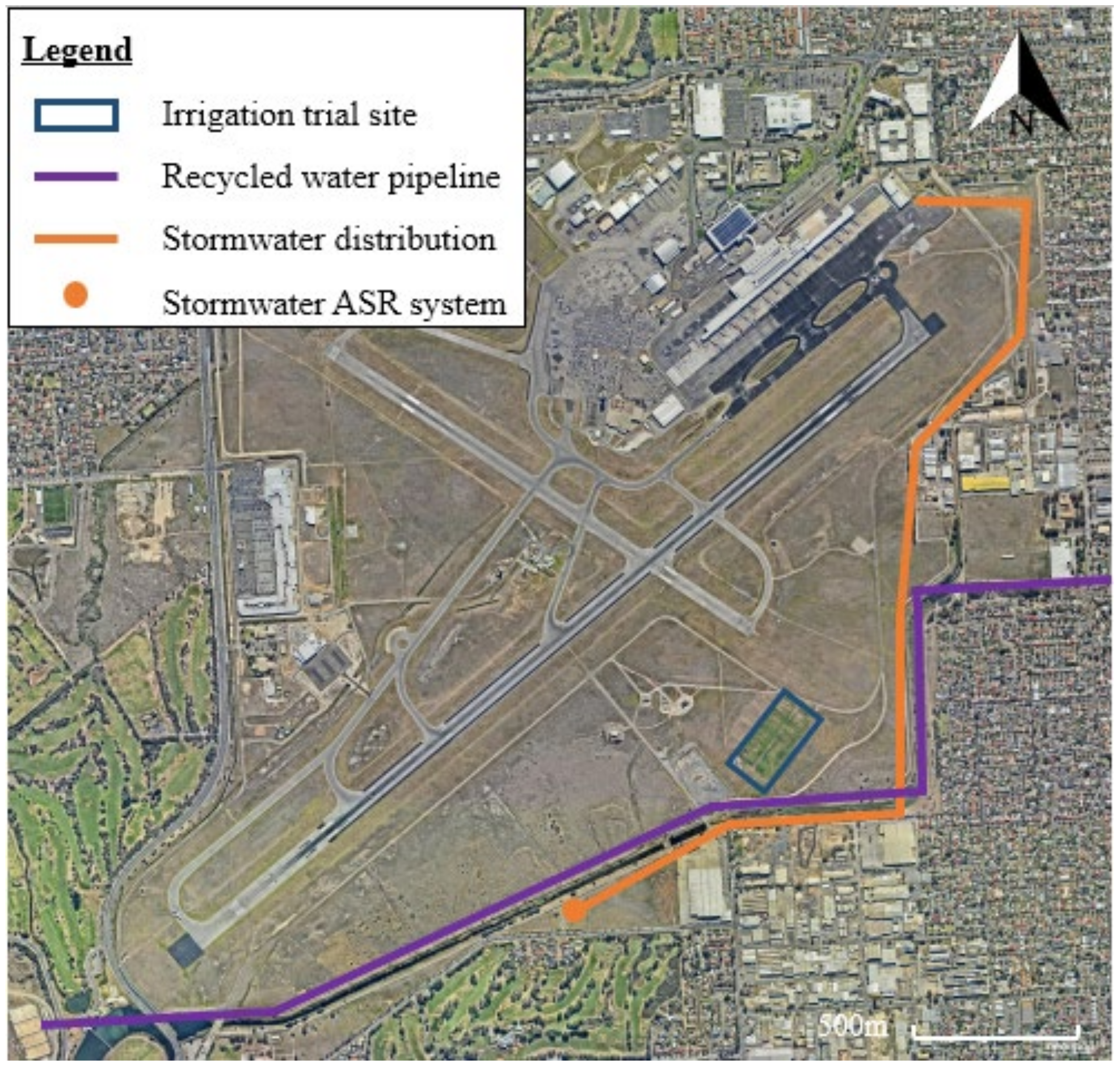
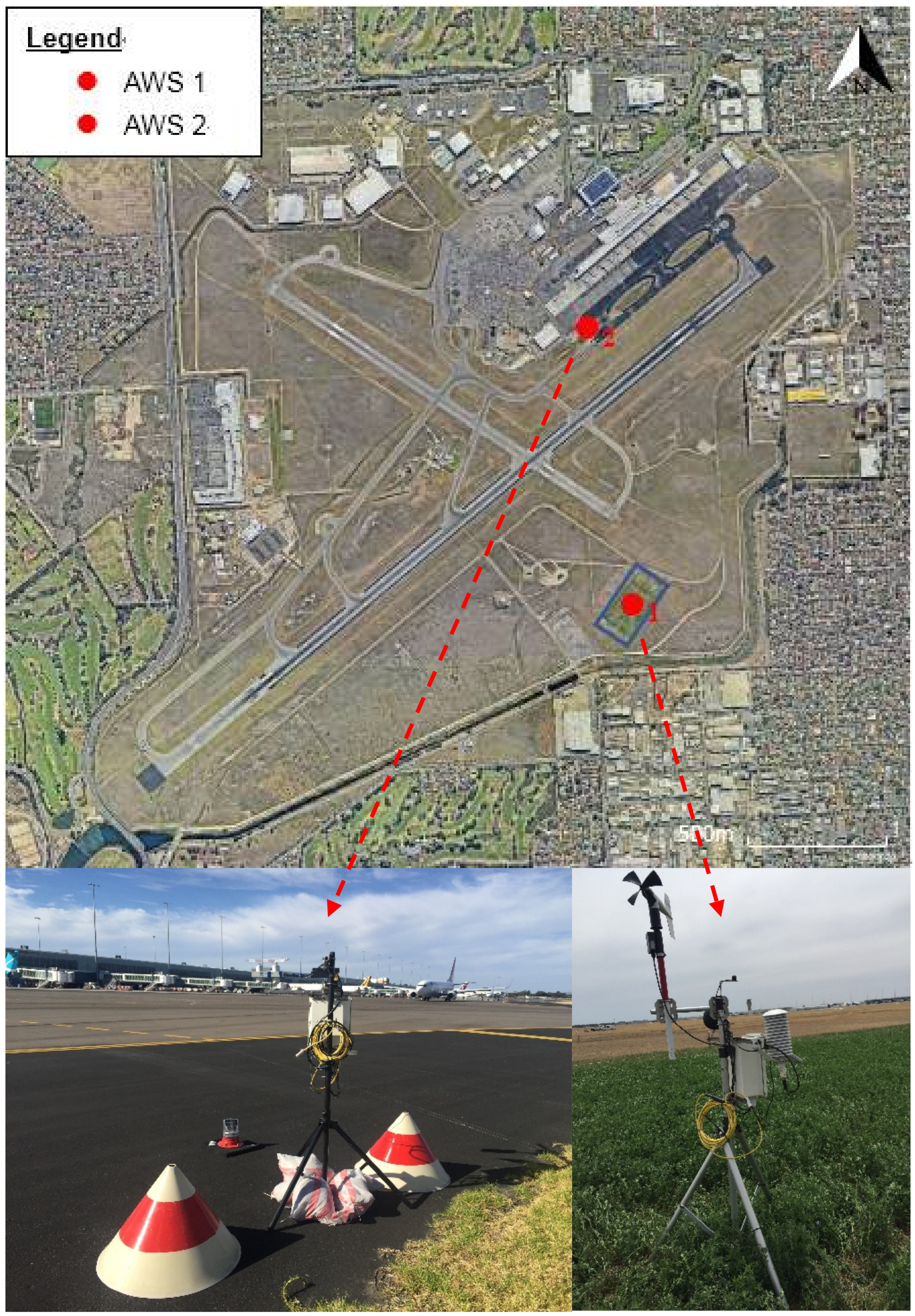
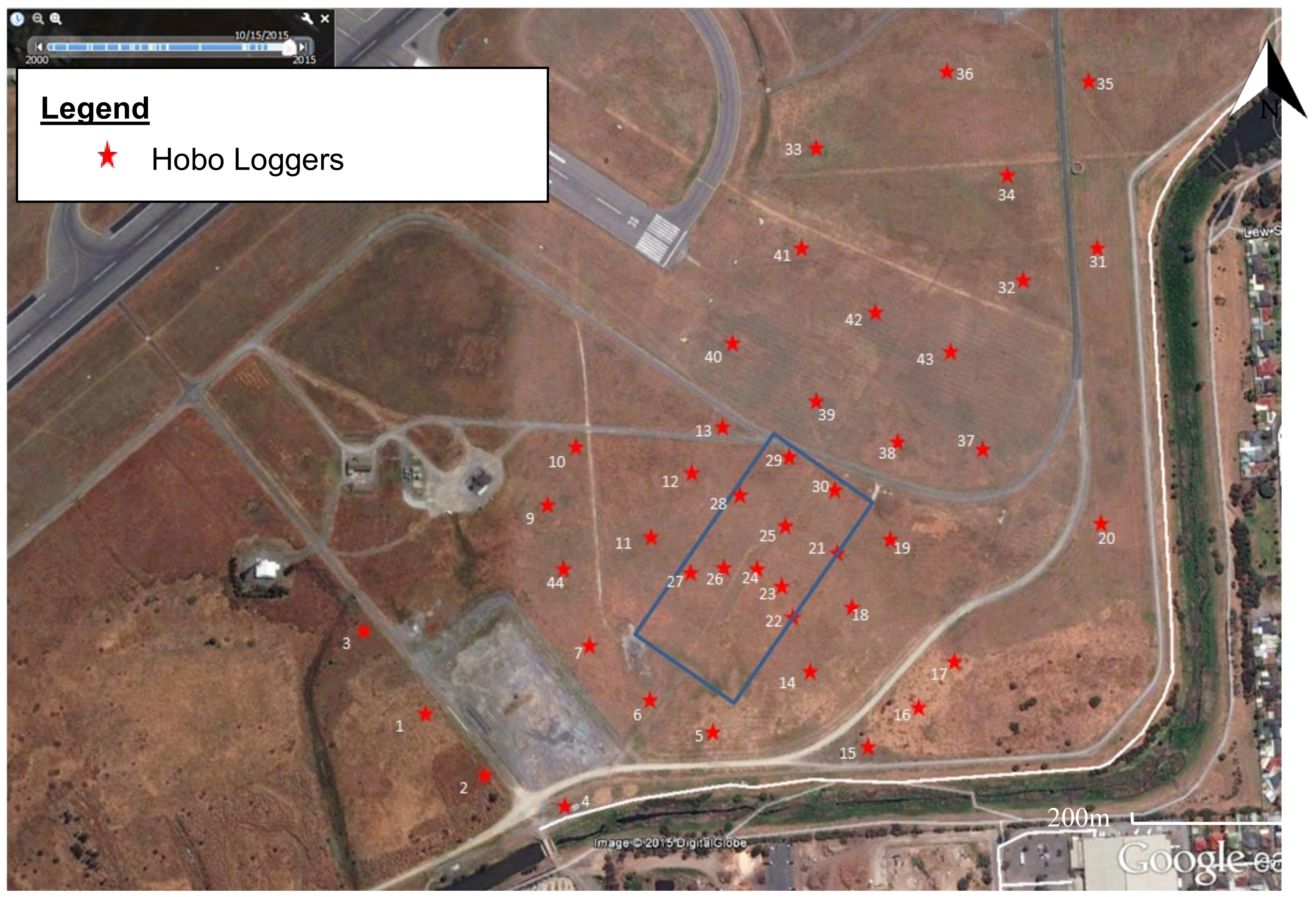

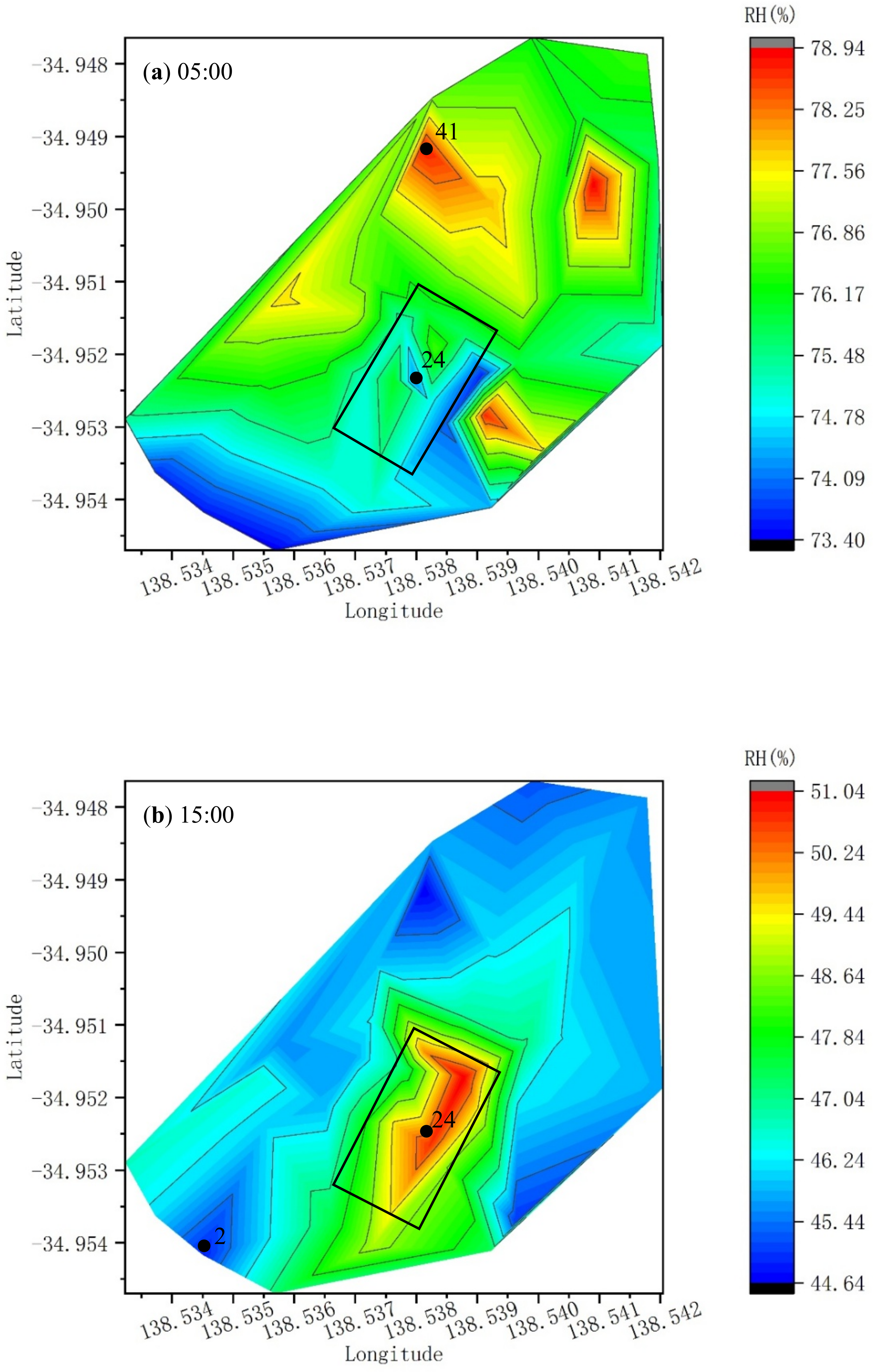

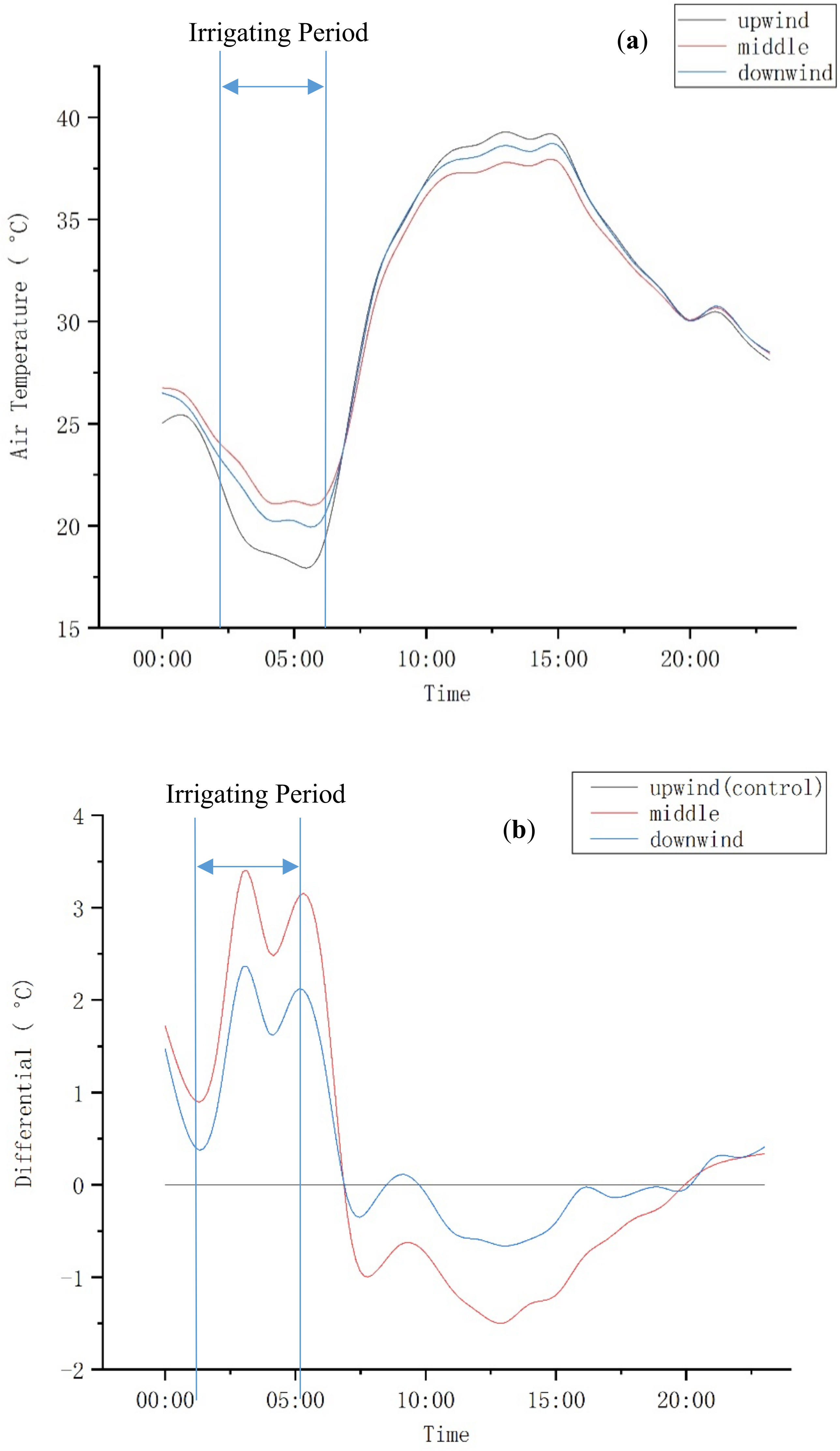


| No. | Equipment | Date | Note |
|---|---|---|---|
| 1 | Hobo Loggers 1–43 | 8 December 2015–11 April 2016 | First round trial |
| 2 | AWS 1–2 | 1 February 2018–1 March 2018 | Second round trial |
| Station | Air Temperature (°C) | Relative Humidity (%) | |
|---|---|---|---|
| 05:00 | Hobo no. 24 | 17.2 | 74.0 |
| Hobo no. 41 | 15.8 | 78.8 | |
| Difference | 1.4 | 4.8 | |
| 15:00 | Hobo no. 24 | 25.2 | 50.7 |
| Hobo no. 2 | 27.0 | 44.9 | |
| Difference | 1.8 | 5.8 |
| Title | Air Temperature (°C) | Land Surface Temperature (°C) | Relative Humidity (%) | |||
|---|---|---|---|---|---|---|
| Apron | Irrigated Grass | Apron | Irrigated Grass | Apron | Irrigated Grass | |
| Whole period average | 23.7 | 23.6 | 31.6 | 23.1 | 51.6 | 57.3 |
| Daytime average | 25.5 | 24.9 | 37.4 | 27.9 | 47.0 | 52.3 |
| Daytime average (max temperature over 30 °C) | 29.9 | 27.8 | 42.8 | 31.1 | 31.1 | 36.5 |
| Maximum | 37.9 | 37.2 | 56.5 | 43.5 | 93.7 | 95.5 |
| Minimum | 11.0 | 13.7 | 17.6 | 8.2 | 16.3 | 19.4 |
© 2020 by the authors. Licensee MDPI, Basel, Switzerland. This article is an open access article distributed under the terms and conditions of the Creative Commons Attribution (CC BY) license (http://creativecommons.org/licenses/by/4.0/).
Share and Cite
Qian, J.; Miao, S.; Tapper, N.; Xie, J.; Ingleton, G. Investigation on Airport Landscape Cooling Associated with Irrigation: A Case Study of Adelaide Airport, Australia. Sustainability 2020, 12, 8123. https://doi.org/10.3390/su12198123
Qian J, Miao S, Tapper N, Xie J, Ingleton G. Investigation on Airport Landscape Cooling Associated with Irrigation: A Case Study of Adelaide Airport, Australia. Sustainability. 2020; 12(19):8123. https://doi.org/10.3390/su12198123
Chicago/Turabian StyleQian, Jingming, Shujiang Miao, Nigel Tapper, Jianguang Xie, and Greg Ingleton. 2020. "Investigation on Airport Landscape Cooling Associated with Irrigation: A Case Study of Adelaide Airport, Australia" Sustainability 12, no. 19: 8123. https://doi.org/10.3390/su12198123
APA StyleQian, J., Miao, S., Tapper, N., Xie, J., & Ingleton, G. (2020). Investigation on Airport Landscape Cooling Associated with Irrigation: A Case Study of Adelaide Airport, Australia. Sustainability, 12(19), 8123. https://doi.org/10.3390/su12198123





